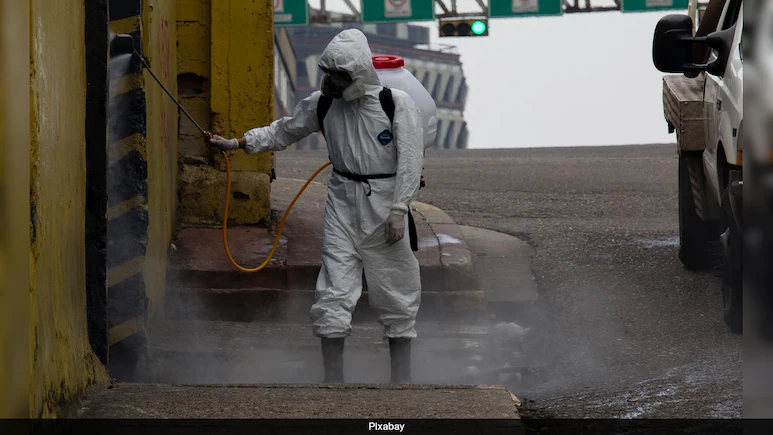The Emergence of the Nimbus Variant: A New Threat in the Covid Landscape
The recent emergence of a new Covid-19 variant, dubbed Nimbus (NB.1.8.1), has caught the attention of health authorities worldwide. The World Health Organization (WHO) is actively monitoring this development due to a noticeable increase in Covid-19 cases attributed to this new strain. Initially identified in January 2025, Nimbus is a sub-variant of the Omicron lineage and is rapidly proliferating in various countries, raising concerns among health experts and the public alike.
According to data shared by the Global Initiative on Sharing All Influenza Data (GISAID), the Nimbus variant has been confirmed in at least 13 states across the United States, including notable hotspots such as California, New York, New Jersey, and Illinois. The situation is equally daunting in the United Kingdom, where the UK Health Security Agency (UKHSA) has reported a 10% increase in hospital admissions related to Covid, reflecting the variant’s increasing impact. In the week ending May 31, a total of 947 patients were admitted with Covid-19 symptoms, emphasizing the urgency of public health responses in the region.
In Asia, countries like China, Singapore, Thailand, and India have also reported troubling trends. India, in particular, experienced a grim milestone this week as Covid-linked deaths surpassed 100, leading health authorities to issue alerts. Although no cases of the Nimbus variant have been specifically reported in India, health officials remain vigilant, prepared to combat any potential surges.
Understanding the Nimbus Variant: Symptoms and Public Health Implications
Identified as NB.1.8.1, the Nimbus variant is categorized as a descendant of the Omicron family. The WHO has classified it among six variants under close observation, likely due to its rapid spread and the potential implications for public health. Dr. Arup Halder, a Consultant Pulmonologist at CK Birla Hospitals, emphasizes that while the naming of variants such as “Nimbus” may not be scientifically recognized, they reflect the ongoing evolution of Covid-19 and its variants.
Symptoms associated with the Nimbus variant reportedly mirror those of previous Omicron subvariants, as outlined by the Centers for Disease Control and Prevention (CDC). Common symptoms include:
– Cough
– Fever
– Fatigue
– Muscle aches
– Congestion
– Headache
– Nausea or vomiting
– New loss of smell or taste
One alarming symptom that has emerged in recent discussions is the so-called “razor blade throat.” This term, popularized by social media, describes an acute, painful sore throat akin to the sensation of having shards of glass lodged in the throat. Dr. Ankita Baidya, a Consultant in Infectious Diseases at Manipal Hospital Dwarka, notes that while the term may be novel, the symptom itself is not. It is seen in both viral and bacterial infections.
According to Dr. Sanjay Rai from the All India Institute of Medical Sciences (AIIMS), the “razor blade throat” occurs in various infections and should prompt individuals with persistent symptoms to take precautions, such as wearing masks and seeking medical attention as needed.
Assessing the Risk: Is Nimbus a Cause for Alarm?
The WHO’s latest risk assessment categorizes the global public health risk posed by the Nimbus variant as “low.” Current vaccines are anticipated to remain effective against both symptomatic and severe cases associated with this variant. From April 21 to 27, Nimbus was detected in 10.7% of globally sequenced Covid-19 cases, amounting to 518 sequences across 22 countries.
Experts like Dr. Baidya affirm that while Nimbus has rapidly spread since its identification, it does not appear to be more deadly than other variants, as it typically results in mild to moderate illness. Dr. Rai reiterates this sentiment, providing reassurance that India’s current Covid situation remains stable, with daily cases hovering between 100 and 200 and minimal hospitalization rates.
The emergence of another variant, referred to as XFG or “Stratus,” has also sparked concern among health officials. However, it is currently not under WHO monitoring. Dr. Baidya indicates that while Stratus is gaining attention, cases associated with Nimbus remain more prevalent. Both variants are currently under close scrutiny as health authorities monitor their patterns of spread and disease manifestation.
The Current Covid Landscape in India: Guidance for the Public
Dr. Halder provides insight into the current Covid situation in India, emphasizing that the country is in a favorable position with low case numbers and limited hospital admissions. He cautions, however, that there is an uptick in respiratory illnesses driven by seasonal viruses, further complicated by the onset of monsoon conditions.
To navigate this evolving landscape, Dr. Halder advises that individuals should rely on guidance from reputable sources such as the Indian Council of Medical Research (ICMR) and the Health Ministry. Those exhibiting severe symptoms should undergo RT-PCR testing to distinguish Covid-19 from other viral infections like the flu. Additionally, ensuring that high-risk groups are vaccinated with booster doses is crucial for protecting vulnerable populations.
Dr. Rai concurs, stating that the overall immunity among the Indian population, bolstered by prior vaccinations and natural immunity from past Covid-19 waves, is likely stronger than that observed in many vaccinated nations.
As the Covid-19 pandemic continues to evolve, the emergence of variants like Nimbus requires vigilance and proactive public health measures. To better understand the implications of these variants and how to protect yourself and your loved ones, consider exploring related articles on[Covid-19VaccinationGuidelines](https://www.cdc.gov/coronavirus/2019-ncov/vaccines/index.html) and[UnderstandingCovid-19Symptoms](https://www.who.int/news-room/questions-and-answers/item/coronavirus-disease-covid-19-symptoms).
Emerging variants like Nimbus showcase the continuous evolution of the SARS-CoV-2 virus, but public health frameworks and personal protective measures can help in managing this ongoing challenge. As per the report by[NDTV](https://www.ndtv.com/), the global community remains committed to monitoring and combating the pandemic’s impacts while prioritizing public health and safety.
DISCLAIMER
We have taken every measure to ensure that the information in this article and on our social media platforms is accurate, verified, and obtained from reliable sources. For feedback or complaints, please contact us at info@hamslive.com.


